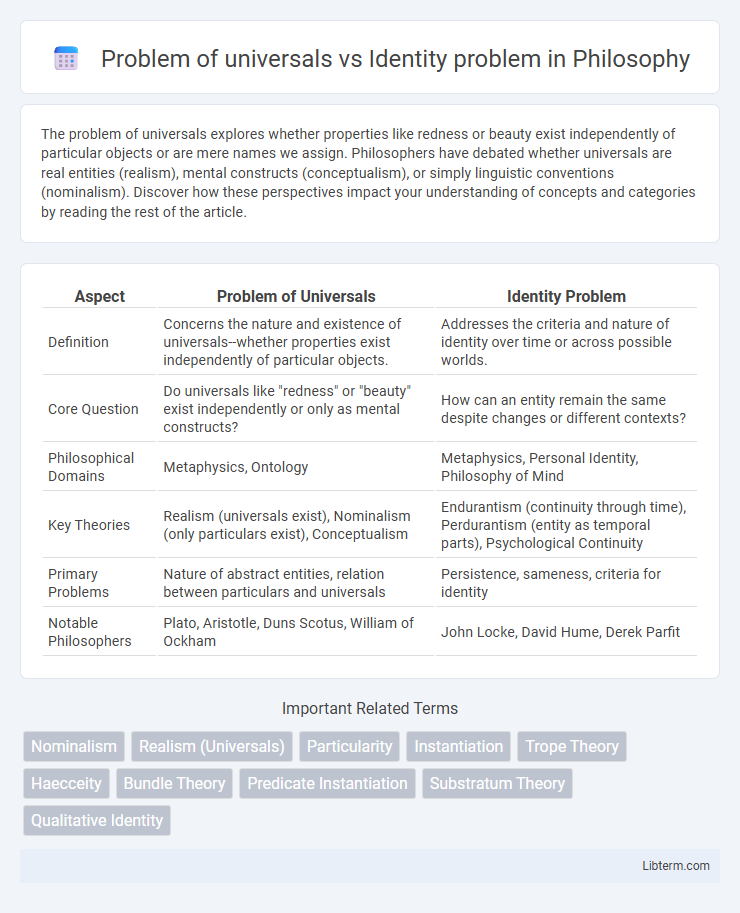The problem of universals explores whether properties like redness or beauty exist independently of particular objects or are mere names we assign. Philosophers have debated whether universals are real entities (realism), mental constructs (conceptualism), or simply linguistic conventions (nominalism). Discover how these perspectives impact your understanding of concepts and categories by reading the rest of the article.
Table of Comparison
| Aspect | Problem of Universals | Identity Problem |
|---|---|---|
| Definition | Concerns the nature and existence of universals--whether properties exist independently of particular objects. | Addresses the criteria and nature of identity over time or across possible worlds. |
| Core Question | Do universals like "redness" or "beauty" exist independently or only as mental constructs? | How can an entity remain the same despite changes or different contexts? |
| Philosophical Domains | Metaphysics, Ontology | Metaphysics, Personal Identity, Philosophy of Mind |
| Key Theories | Realism (universals exist), Nominalism (only particulars exist), Conceptualism | Endurantism (continuity through time), Perdurantism (entity as temporal parts), Psychological Continuity |
| Primary Problems | Nature of abstract entities, relation between particulars and universals | Persistence, sameness, criteria for identity |
| Notable Philosophers | Plato, Aristotle, Duns Scotus, William of Ockham | John Locke, David Hume, Derek Parfit |
Defining the Problem of Universals
The problem of universals centers on whether properties such as redness or beauty exist independently of particular objects or solely as mental constructs. Philosophers debate if universals are real entities (realism) or merely names without inherent existence (nominalism). This issue directly challenges the understanding of identity by questioning how distinct objects can share common traits while maintaining individual uniqueness.
Understanding the Identity Problem
The Identity Problem examines how individual entities maintain their distinctness over time despite changes in properties or context, challenging the notion of fixed identity. It contrasts with the Problem of Universals, which questions how universal concepts apply to multiple particular instances without losing specificity. Understanding the Identity Problem involves exploring criteria such as continuity, resemblance, and causal connections to define when an object remains the same entity.
Historical Context: Philosophers on Universals and Identity
Medieval philosophers like Thomas Aquinas and John Duns Scotus debated the problem of universals, emphasizing whether universals exist independently or only as mental concepts. Aristotle's notion of substance and essence laid foundational ideas for identity, distinguishing between what something is and its individual existence. Later, Gottfried Wilhelm Leibniz introduced the principle of the identity of indiscernibles, asserting no two distinct entities can share all properties, thus influencing modern views on universals and identity.
Realism vs Nominalism: Competing Views on Universals
Realism asserts that universals exist independently of particular objects, serving as abstract entities that explain shared properties like redness or beauty. Nominalism denies the existence of universals as abstract entities, claiming that only individual objects and their names or labels exist, with commonalities arising from linguistic conventions rather than metaphysical realities. This debate addresses how identity and sameness across different instances are understood, influencing metaphysical and epistemological frameworks in philosophy.
The Nature of Individuality: The Core of the Identity Problem
The Nature of Individuality lies at the core of the identity problem, raising questions about what makes an entity uniquely itself across time and change. Philosophers debate whether identity depends on intrinsic properties or relational and contextual criteria, addressing challenges like persistence and change in objects and persons. This issue connects deeply with the problem of universals, which concerns how shared properties relate to individual entities, complicating the understanding of singularity and permanence in metaphysics.
Universals and Particulars: Bridging the Conceptual Gap
Universals represent properties or qualities shared by multiple particulars, serving as abstract concepts that unify diverse instances under common characteristics. Particulars are individual entities that instantiate universals, embodying unique configurations in space and time. Bridging the conceptual gap involves exploring how universals can exist independently or dependently on particulars, addressing challenges in metaphysics about the nature of reality and the relationship between generality and specificity.
Identity Through Time: Persistence and Change
The Problem of Universals intersects with the Identity Through Time debate by challenging how objects maintain persistence amid change while retaining their fundamental identity. Philosophical theories such as endurantism argue that entities are wholly present at every moment of their existence, ensuring continuity despite alterations. Alternatively, perdurantism proposes that objects are four-dimensional entities extended in time, composed of temporal parts, which collectively explain identity through change without requiring strict universality.
Ontological Commitments: What Exists?
Ontological commitments in the problem of universals address whether abstract entities like properties and universals exist independently or only as mental constructs. The identity problem questions what it means for an entity to be the same across time or different contexts, challenging the criteria for individuation and persistence. Both issues critically examine what types of entities populate reality, forcing philosophers to clarify their ontological assumptions about existence and the nature of being.
Intersections and Divergences: Comparing Universals and Identity
Universals and identity both address how entities relate to shared properties and individuality, yet universals emphasize common features existing across multiple instances, while identity focuses on the uniqueness and persistence of a single entity. Intersection occurs when discussing whether shared characteristics imply a universal essence or differ across individual identities, influencing theories in metaphysics and ontology. Divergence emerges in that universals seek a common explanatory principle for properties, whereas identity struggles with criteria for exact sameness over time and context.
Implications for Metaphysics and Contemporary Philosophy
The problem of universals challenges the metaphysical grounding of properties, raising questions about whether universals exist independently of particular objects, which directly impacts debates on identity and persistence over time. The identity problem examines criteria under which entities remain the same despite change, crucial for understanding personal identity, objects, and concepts in contemporary philosophy. These issues inform metaphysical theories by shaping views on ontology, essence, and the nature of reality, influencing analytic philosophy, phenomenology, and modal metaphysics.
Problem of universals Infographic

 libterm.com
libterm.com